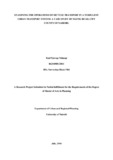| dc.description.abstract | Non-Motorized Transport (NMT) is a dominant mode of transport in many African Cities. In the City County of Nairobi, the mode account for almost 50% of all trips made. The NMT mode faces a number of challenges, largely due to the secondary consideration given to the mode by policy makers and administrators. The mode is not well integrated in the transport system of the City. Ngong Road, a standard carriagewaywith two traffic lanes, passes through the study area and links the city of Nairobi with Ngong Town. There is inharmonious interaction between motor vehicles and cyclists along this road where cyclists are seen as nuisance and intruders of space meant for the motor transport (MT).
The objectives of the study were to establish the role of bicycle transport in the urban transport system within the area of study, to investigate the status of cyclists‟ infrastructure on road designs along Ngong Road, to examine the challenges /constraints of bicycle transport and to propose plausible cyclists‟ related planning interventions to properly integrate bicycle mode in urban transport system along Ngong Road.
The study employed descriptive survey to examine the operations of bicycle transport along Ngong Road. Convenient sampling method was used when interviewing cyclists. Cluster sampling method was used to capture data from the households. An observation survey was also carried out to come up with the transportation modal split (traffic counts) along this road.
The study revealed bicycle as a convenient, affordable, fast and flexible means of transport for short distances. Despite its desirable characteristics most city residents have avoided it since it is prone to accidents due to lack of dedicated bicycle tracks and associated infrastructure and services along Ngong Road.
The study concluded that the bicycle has a role to play in the study area but there lacks the infrastructure to support bicycle mode. As such there are many challenges that face this mode which are attributed to lack of secluded bicycle tracks system along Ngong Road.
The research recommended effective planning for NMT transport through provision of adequate funds to support cycling infrastructure, develop supportive NMT legal (policy) and institutional framework, promoting good governance and prioritizing integration of NMT with MT. With the NCC NMT policy of 2015, it‟s envisaged that mobility environment will be facilitated where all transport modes will be of equal importance. | en_US |



